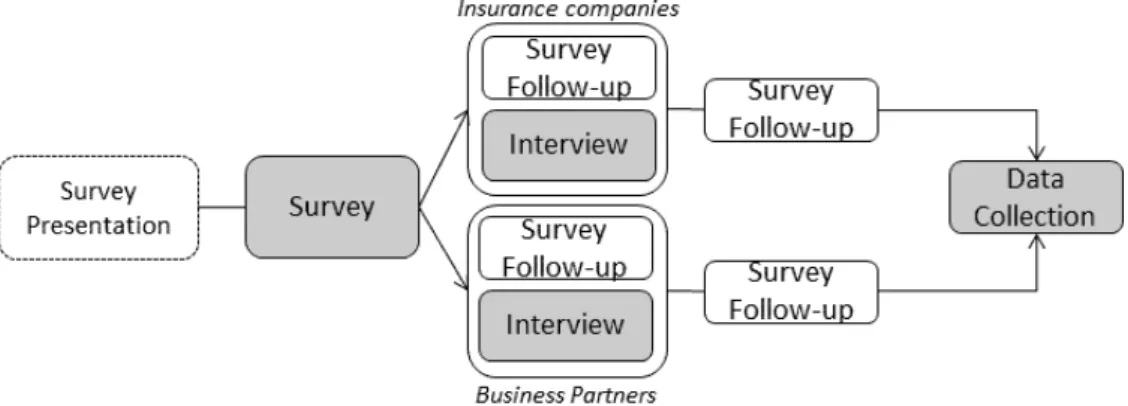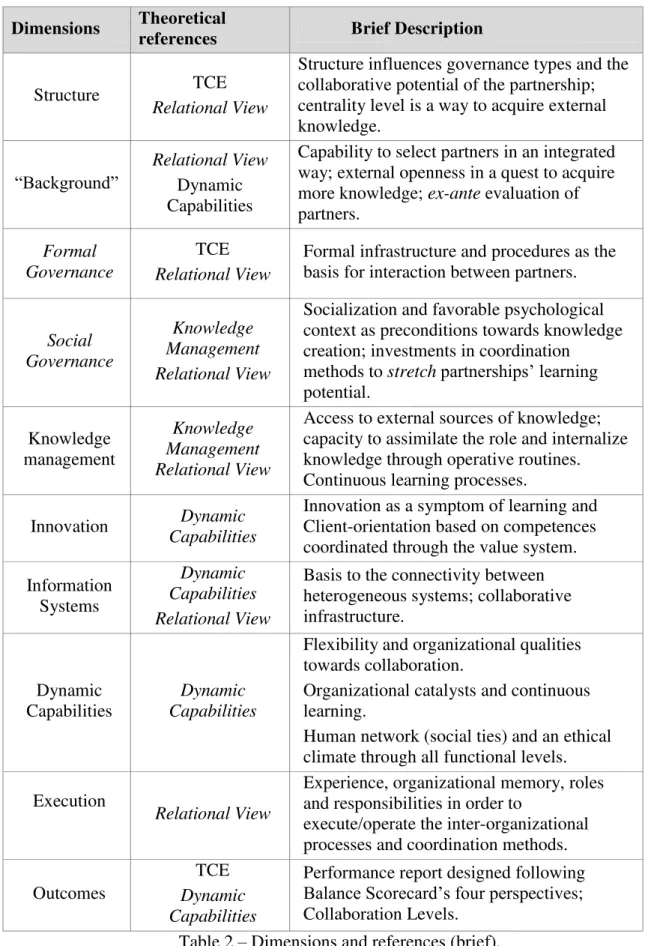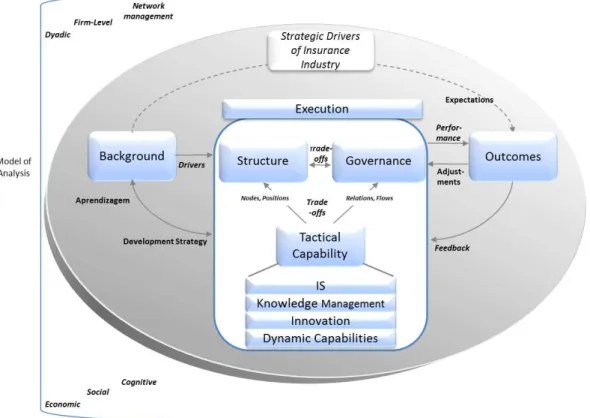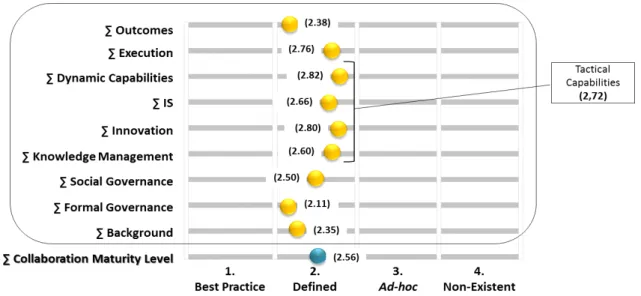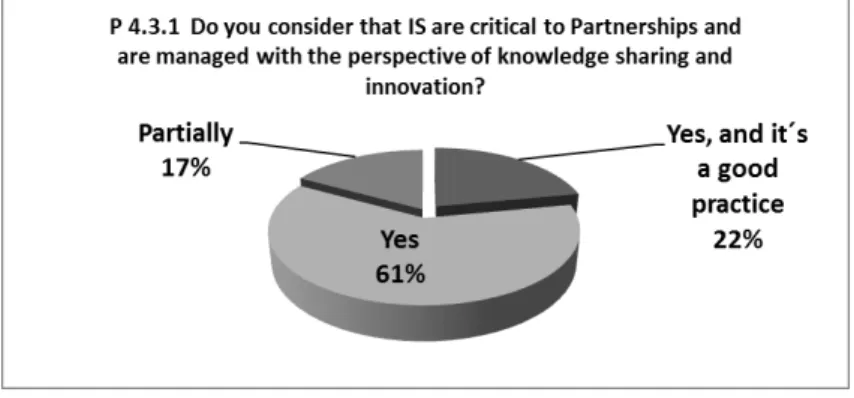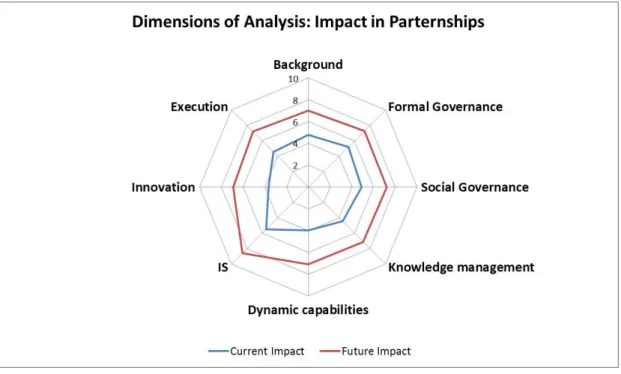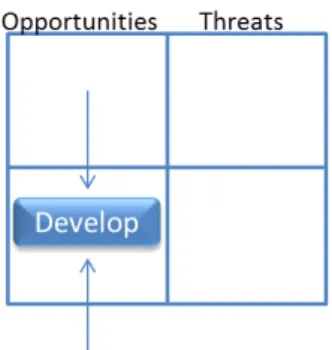DOI: 10.4301/S1807-17752013000300001
_____________________________________________________________________________________ Manuscript first received/Recebido em 29/06/2012 Manuscript accepted/Aprovado em: 09/07/2013 Address for correspondence / Endereço para correspondência
Bruno Alexandre Ribeiro Marques, Catholic University of Portugal, Invited Professor, iLIDH Institute, Portugal, ResearcherPortugal Master in Business from Universidade Católica Portuguesa (UCP), MBA (UCP) and PhD from Universidade de Aveiro, He is currently member of the Technology Department and coordinator of IT Governance and Best Practices committee at Açoreana Seguros Insurance Company. He collaborates with universities as a professor in the fields of Information Systems, Knowledge Management and Change Management. He is also an investigator in the areas of Information Systems and Organizational Development. He was as a consultant role in the areas of Management and information systems in national and multinational companies. Address: Av. General
THE DEVELOPMENT OF VALUE SYSTEMS AND THE ROLE OF
INFORMATION SYSTEMS IN THE PORTUGUESE INSURANCE
INDUSTRY
Bruno Alexandre Ribeiro Marques
Catholic University of Portugal, iLIDH Institute, Lisbon, Portugal
__________________________________________________________________________
ABSTRACT
This study aims to analyze the status of partnerships between organizations in the Portuguese insurance industry and design a development strategy that includes the Information Systems (IS) dimension. In this paper, the current role of the IS in insurance partnerships (e.g.: automation of functionalities, alignment with decision makers) is analyzed, as well as their importance in the future. Since insurance information activities are knowledge intensive, a relational and learning approach was followed. The impact of the IS on collaboration and implications for the CIO (responsible for the IS) are presented. The existence of a good exploration of the IS for automation and integration of heterogeneous systems were verified. However, collaborative functionalities (e.g. Web 2.0) and partnership management indicators were not observed as a common practice. The CIO can be an agent of change, highlighting the IT Governance view and the socio-technical approach that are key to increase the maturity and value of the IS in the insurance industry.
Keywords: Inter-organizational relationships; levels of collaboration; impacts on the
Information Systems; IT Governance
1. INTRODUCTION
In 2005, the author concluded his Master’s thesis "Impact of the Internet on the Primary Activities of the Insurance Industry in Portugal" which focused on the internal
directly related to the dynamics of the external relationships and subsequent level of collaboration between companies and their partners. The effective articulation between insurance management and information systems (IS) aims to recognize the informational needs of decision makers and introduce essential IT tools, collaborative processes and sharing culture, therefore increasing the value of information as a meta-resource of management (Ward and Peppard, 2002).
The Value Systems context, which is more integrated, emphasizes the relevance of a socio-technical approach in the IS implementation in the insurance industry. Therefore, the technological proposal should be framed in a broader sense of the business strategy and organizational maturity levels.
The object of analysis
This study focuses on the value systems, the inter-organizational space where companies collaborate in order to offer high-valued services. In this context, we intended to study the current status of inter-organizational partnerships in the Portuguese insurance industry, understand the dynamics of its relationships, taking into account its competitiveness. Essentially there are three reasons for this:
Insurance companies adhere effortlessly to the value system concept. In fact, they can be conceptualized as a big hub making business connections among a full array of external organizations, being therefore fertile soil for innovation management.
The insurance industry has a pivotal role in Portuguese economy. In 2009, this industry represented 8.9% of the GDP and is an activity with a crucial role in the economy and consolidation of the social and economic progress.
Insurance is an information and knowledge-intensive activity (Porter and Millar, 85). The alignment between information and business is absolutely crucial, as well as the exploration of partnerships with a relationship and knowledge view, taking innovation and client-driven orientation into account.
Specifically speaking, the value creation and competitiveness of insurance companies are intertwined with the quality of service of a large array of external organizations.
Information, knowledge and network era
The technological development we see nowadays is the fastest in our history and is motivated by the scientific progress and convergence of communication, multimedia and information technologies. The availability of information, forerunner of knowledge, influences the works of society and economy with strong impacts on the corporate arena.
The Network Society (Castells, 2002) is one of the most powerful metaphors about the new throb we see explaining the diffuse, super symbolic (Toffler and Toffler, 1995) and multifaceted reality in which we move.
A new competitive dynamics
advantages and management principles (Lei and Scolum (2002); Senior (2000), Bartlett and Goshal (2001). In this new competitive dynamics, intangible factors are highlighted as the engine of economic development (Carneiro (2003), Davenport and Prusak (1997) and Magalhães (2005). Knowledge capital is currently a source of market differentiation and is comparable to the increase of importance of intangibles. This allows the learning process to renew the knowledge and the capacity of making it useful, and thus promoting it to the strategic realm. The inter-organizational context adheres to this new logic of collective intelligence since the intangible factors only have value if used and only multiply if they flow.
Problem, Objective and Approach
Management Problem: Value creation in the insurance industry
The insurance industry context is highly competitive because of its complexity, high level of technicality, and high rate of change. Therefore, it brings about the search for better efficiencies, systematic adjustments to market conditions and sources of competitive differentiation. In this sense, with the value creation in the insurance industry in mind, the following management problems were identified:
Management challenges
What strategic vision could be foreseen in the insurance industry considering the new competitive environment?
Which are the keys for competitive differentiation assuming that external openness, strategic collaboration and learning are new strategic strengths?
How to build, in a consistent manner, a strategy based on intangible resources – namely, information, innovation and knowledge?
In light of value systems principles, how to manage partners, relationships and processes, in order to create value and in an integrated way?
Table 1 – Management challenges
According to the context described, the response systems in the insurance industry, necessarily of variable geometry, should demonstrate the capacity to adapt and materialize opportunities through the development of an inter-organizational collaborative system. Therefore, we suggest that the race towards competitiveness in the insurance industry is also a race towards the development of value systems.
General objectives
Specific objectives of IS Management in the insurance industry
For the purpose of this paper, it is important to provide the general aspects of the analysis, the "forest". The focus will be on the IS aspect, the "tree", and how it should be aligned with the evolution of relational networks in the insurance industry –
“conceive the tree integrated in the forest”.
Regarding the IS aspect in the framework of the development of value systems in the insurance industry, the following specific objectives were proposed:
Verify the current role of the IS in partnerships;
Verify the level of management maturity of the IS in light of an integrated model;
Verify the impact of the IS on partnerships;
Verify the effect of the IS in the level of collaboration among partners. These four objectives comprise the core of this paper.
The approach to the inter-organizational networks in the insurance industry
The more one recognizes that value creation is a result of activities performed in articulation with the exterior, the more the interest towards the inter-organizational space increases (Dyer and Singh, 1998). The new mental framework, which moves from productivity to relationships (Castells, 2002), requires a certain level of disruption. Nonetheless, the concept of relationship networks has been analyzed in many frameworks (Begnis, Pedrozo and Estivalete, 2008). In the case of the networks in the insurance industry, the approach taken by the motivation of relationships between peers in this industry comes first. The insurance product is immaterial, information and knowledge intensive. The challenge is to benefit the demand side, searching for a more effective relationship with the market. In this context, the motivation in this industry should be the development of internal competences, access to external specialized resources, operational flexibility and service innovation (Carvalho, 2002). These needs can be fulfilled through interactions with other economic agents, i.e., through the collaboration between peers. Our approach should therefore underline Innovation, Learning and Service.
The value system in the insurance industry and information
In the insurance industry, the emphasis is on multi-relationships (Carvalho, 2002 and Cummins and Doherty, 2005), i.e., the interconnections between insurance companies and partners, reinforcing a value system centered in the Client and in a superior focus on services (Silveira, 2008). Information is a management meta-resource that accompanies the internal value chain and the external relationships in the strain of computerization or through the incorporation of knowledge for a more sophisticated commercial dynamics (Vanharanta and Breite, 2003).
In summary, given the nature of the value activities and the “outside in”
perspective, enhancing the collaborative level of the value systems. Managers in the insurance industry should have an integrated and strategic perspective of partnership networks as to better explore the potential of information.
The largest interdependence among economic agents reaches out to the strategic management of the IS, among other dimensions, supporting the processes that have a tendency towards collaboration, making current information available to decision makers and operative models more agile (Nooteboom, 2006).
Methodology
Using the hypothetical-deductive method, an abstract systematization was taken and followed by real and concrete observation. The methodology was based on the following steps:
Conceptual mastery of the topics, discerning the atomic properties of value systems
Empirical /Field research: Validation of the propositions through data gathered from targeted questionnaires. To complement, face-to-face interviews were conducted with the target audience (see figure 1).
Figure 1 – Methodology for Empirical Verification
The data analysis comprised a descriptive analysis and a hypothesis test to verify the influence (correlation) of the dimensions in the degree of collaboration in the industry.
Proposed Analysis Model
Dimensions Theoretical
references Brief Description
Structure TCE
Relational View
Structure influences governance types and the collaborative potential of the partnership; centrality level is a way to acquire external knowledge.
“Background” Relational View Dynamic Capabilities
Capability to select partners in an integrated way; external openness in a quest to acquire more knowledge; ex-ante evaluation of
partners.
Formal Governance
TCE
Relational View
Formal infrastructure and procedures as the basis for interaction between partners.
Social Governance
Knowledge Management Relational View
Socialization and favorable psychological context as preconditions towards knowledge creation; investments in coordination
methods to stretchpartnerships’ learning
potential. Knowledge management Knowledge Management Relational View
Access to external sources of knowledge; capacity to assimilate the role and internalize knowledge through operative routines. Continuous learning processes.
Innovation Dynamic
Capabilities
Innovation as a symptom of learning and Client-orientation based on competences coordinated through the value system.
Information Systems
Dynamic Capabilities Relational View
Basis to the connectivity between heterogeneous systems; collaborative infrastructure.
Dynamic Capabilities
Dynamic Capabilities
Flexibility and organizational qualities towards collaboration.
Organizational catalysts and continuous learning.
Human network (social ties) and an ethical climate through all functional levels.
Execution
Relational View
Experience, organizational memory, roles and responsibilities in order to
execute/operate the inter-organizational processes and coordination methods.
Outcomes
TCE
Dynamic Capabilities
Performance report designed following
Balance Scorecard’s four perspectives; Collaboration Levels.
The presented figure 2 allows the visualization of the GPS model proposed:
Figure 2 – GPS Analysis Model (Integrated Partnership Management Model for
the Insurance Industry) (note: Author’s analysis).
The GPS model proposed addresses the following main issues:
Incorporates the fundamentals of inter-organizational partnerships, introducing a new vision based on the economic, social and cognitive trinomial;
It is consistent with the various perspectives of network analysis: dyadic, intra-firm and network relationships;
Presents a system of relationships that include bidirectional flows and connections.
Limitations of the stratified sample
Twenty questionnaires were collected and thirteen face-to-face complementary interviews were conducted. Therefore, it is pertinent to explain the limited quality of the data. Since the sample is not perfect, the immediate extrapolation of the data to the universe cannot be done in a definitive manner. However, from a stratification of the sample it was possible to involve insurance top managers representing approximately
74% of the “Non-Life” portfolio and over 50% of the “Life” portfolio. We argue that the referred limitation occurs from the nature of the phenomenon in analysis itself, specifically for the following reasons:
The level of disruption of the concepts does not suggest the generalization of the questionnaires.
Results
General Maturity of the Insurance Value System
Each dimension of the proposed model of analysis (GPS) was expanded in categories and indicators, resulting in the questions of the inquiry. The answers were collected considering a maturity scale, as shown below, giving us a picture of the current collaborative practices in the insurance industry.
1 1,5 2 2,5 3 3,5 4
1
Best practice
2
Defined
3
Partially Defined / Ad hoc
4
Non existent
Figure 3 - Scale of levels of maturity.
Maturity levels represent the degree of formality, stage and capacity to gather metrics and structure processes. In this context, we followed a continuous improvement orientation, considering IS as a service, which implies process definitions, organizational roles and measurable business objectives (IT Governance Institute, 2007, Galliers and Leidner, 2003). The maturity scale adapted from CMMI levels (IT Governance Institute, 2007; Smith, 2012) was the following:
Best practice: processes are defined, measured, reviewed and optimized;
Defined: processes are defined, normalized and have metrics;
Partially Defined / Ad hoc: processes are partially documented, executed but in a general way;
Nonexistent: processes are not executed.
Figure 4 – Overall Maturity Level of Insurance Value System and its components.
General understanding of the Scale of Dimensions of Maturity The overall data of the as-is maturity level of each dimension gives us a big picture of collaborative practices in the insurance industry. Following, theten key-issues to retain are:
The general collaborative level is currently at an intermediate point (2.56). It
could be in the path towards a “Best Practice” but it also could slip to an “Ad
-hoc/Partial” level.
The relevance of each dimension was highlighted, proving the multi-disciplinary nature of business partnerships and the need for a holistic management model.
Currently, the domains with high levels of maturity are the more formal and structured ones. On the other hand, Innovation and Dynamic Capabilities, soft issues,
are in lower stages.
The value system seems to be more economic-intensive (economic factors are more valued) rather than knowledge-intensive (innovation and collective learning factors are less observed in the collaborative space). This translates into a more transactional and less collaborative framework.
Complementarity (having several partners with weak ties) is more valued than Proximity between business partners (having strong ties with fewer entities with a resilient trust).
The optimal cognitive distance could be at stake. One issue to further investigate is if the current level of trust, merely in a rational basis, and an insufficient
level of commitment are blocking the potential of collaborative processes.
The objective of incremental innovation and the nature of the business suggest Strength of Strong Ties as model of interaction. As this approach is not yet fully
implemented, there is a strategic gap regarding the as-is model of collaboration in the sector.
Alongside the gap regarding external openness, endogenous factors should
be improved as the internal network conditions the external network outcome.
There is a high level of formality in Business Partnerships that stress a transactional view of the collaboration. Although there is some appreciation of relational capabilities, this is not yet the standard. Nonetheless, these types of capabilities will have a high impact on the future, as the inquiries show.
The key is how to expand the more critical and less mature dimensions towards a better management of business partnerships in the near future.
View of the role of Information Systems in the management of partnerships
The model of analysis proposed considers Information Systems (IS) as a required dimension. Although needed, it is not sufficient and insights about this crucial
dimension are relevant for partnerships’ effectiveness. We will show in detail the
analysis of the role of IS in business partnerships.
Insight #1 The Overall role of IS in Partnerships.
83% of the respondents highlighted the critical role of IS and only 17% partially value the IS in partnerships. None of the respondents mentioned IS as a non-important dimension.
Figure 5 – Characterization of the overall importance of IS.
Insight #2. IS maturity level
In general, the IS maturity level is “2.66” corresponding to the second half of the
“2. Defined” Level. This is a relatively low level considering the current technological
seems to be guaranteed. But the introduction of the IS with another type of range is somewhat limited in this stage. In fact, based on the transactional data mentioned, it is possible to reach analytical insights, such as real time business indicators, giving managers the opportunity to make decisions in a timely manner – with gains in effectiveness (Ward and Peppard, 2003; Austin, Nolan and O´Donnel, 2009). The development of collaborative 2.0 platforms (MacAffe, 2006) is another issue with high potential and not yet fully explored, particularly in a context where the frequency of interactions would benefit from communication, collaboration and knowledge management tools.
Details about IS maturity level
IS Dimension
Topics Average
Executive information systems (EIS) 3.11 Web 2.0 (collaborative functionalities) 3.79 Knowledge management systems 3.21
Workflow 2.16
Portals 2.11
Training and teamwork 2.00
Strategy 2.42
∑
Information Systems 2.66
Figure 6 – Components of IS Maturity Levels
Operational Level [2.11 of maturity]: the joint reading of Extranet Portals and Workflows allows us to identify good performance in managing transactional data.
Management and Executive Levels [3.11 of maturity]: there is room for improvement concerning the management of information at an intermediate level, comprising business indicators and decision support in selection of potential partners – currently there is a maturity gap.
Knowledge Management and Collaboration [3.5 of maturity]: Collaborative tools with semi-structured information, connecting both operational and management levels in real-time are high potential systems yet to be deployed.
According to this rating, it is possible to get some new insights from this dimension:
SI – Types of IS at Partnerships
Topics Average
KMS and Collaborative Systems 3.50
Management and Executive levels 3.11
Operational level 2.11
∑ Information Systems 2.66
Figure 7 – IS types and impact on Partnerships.
Regarding the existing gap in Management and Executive Levels, question
P4.3.8 “Are there business indicators about partnerships, contact lists (yellow pages),
partnership performance, etc.?”, over 50% of the respondents answered that they get this type of information only partially and almost 15% stated that they do not get it at all. Insights about decision support systems for Partnerships were asked in question
P4.3.9 “Is there a mechanism for decision support in the selection process of partners?” and 58% of the respondents answered negatively. Regarding the Knowledge Management and Collaborative Systems, the gap was observed through question P4.3.7
“Do you have IS to support Knowledge Management among Partnerships,
namely,Databases of best practices, document sharing, information sharing, etc.?” Only
positive answers. Almost 80% of respondents stated that they had not implemented any of these functionalities. In general terms, the above IS maturity stage in the insurance industry seems to follow the classic pattern of IS evolution in organizations, i.e., progressing from transactional systems at an operational level to internal integration and superior management levels, with the need of less structured information. This behavior implies an improvement of the strategic alignment and a business-driven IT management model to overcome this gap.
On one hand, IS are already fully implemented at an operational level granting internal rationalization (Venkatramen, 94; Galliers and Leidner, 2003). On the other hand, impact at business network redesign level is not yet explored. Therefore, there is room for improvement concerning the IS management model: from the existing hard technological perspective to a more business-driven orientation, implementing soft issues such as collaborative functionalities, change management and business alignment, as well as a clear vision of maturity levels in light of IS best practices.
Insight #3. IS’s future role
Firstly, we will present the overall expected roles of all the dimension of analysis, comparing the as-is values vs. their future impact on partnerships.
Figure 8 – Current and future Impact on partnerships of the dimensions of analysis.
Still regarding the current impact of the dimensions of analysis, in general, soft issues have less relevance.
In fact, Knowledge Management, Innovation and Dynamic Capabilities are less valued in the present, being high potential issues to explore in this context. In the future, a more homogenous appreciation of the dimensions of analysis is projected, aiming a superior collaborative level among peers. The future collaborative stage also stresses the importance of formal and social governance, now equidistant, and Execution is being
pushed forward. Concerning the impact of IS in the present, its’ importance is already recognized as being instrumental for business partnerships and valued as the most important dimension. This impressive fact is expected to continue in the future stage of partnerships, as IS are referred as a key-issue. However, hard components of IS (ex: partnerships indicators) and soft components (ex: collaborative functionalities) are projected to have more weight.
Insight #4. IS impact and collaborative levels
Through inductive data analysis a correlation test between the dimensions of our model was performed. Using SPPS software, a dependent variable was fixed
(“collaboration level”) and in light of our hypothesis, the positive effects of each
dimension were tested. For the purpose of this paper, we will only mention the positive correlation observed between the IS dimension and the level of collaboration and maturity between partners.
Conclusions
Strategic direction: “development”
From what has been stated, it is possible to systematize a set of opportunities that would enhance inter-organizational relationships. In the insurance industry, business partnerships are an opportunity to develop strategically, towards a more differentiated value proposal, supported by a proper alignment between insurance companies and specialized business partners.
Figure 9 – SWOT analysis of insurance partnerships (Brief).
General challenges of collaboration
This strategic direction reflects a change of perspective, generating a new mental model of greater service orientation, learning and engagement of strong ties with
aspects of today’s collaboration stage and the major challenges towards a more mature
partnership management in the insurance industry.
Partnerships are not yet being used as a way to adapt to market conditions and mitigate strategic drift risk.
Partnerships are not being managed in light of Knowledge Management and Innovation to obtain differentiation in the market.
There is not enough effort to transfer tacit knowledge between partners and there is some resistance to external openness.
Business partnerships are being managed by stressing formal issues rather than using a global and broader strategy of development.
A set of sophisticated competences of business partners is already available, increasing the potential outcome of inter-organizational partnerships.
The definition of expectations between entities, through the complete life
cycle, is blocking the partnership’s outcome.
The companies’ current mental model calls for command-control management systems, not suitable to a more collaborative business model.
The current Social Governance level is not adequate with the expectation of
Knowledge creation, considering the ambition to develop partnerships with a more collaborative weight.
Strong ties vs. Diversity (of partners) should be balanced in order to achieve
an optimal cognitive distance. Relational Risk should be mitigated through the
reinforcement of ties.
Internal and external networks should be aligned. Insufficient absorptive capacity (internally) could block more collaborative relationships (externally).
The role of the IS is highlighted in the present and in the future. However, a change in the management role of the technological offer is required, combining hard
and soft capabilities. Therefore, a new IS management model could be foreseen. Specific IS challenges
In summary, the specific IS challenges are the following:
Challenge #1: Insurance IS follow the traditional path: more maturity at an operational level with consolidated transactional systems and general usage of Portals, but less maturity in exploration of executive information and insufficient deployment of collaborative functionalities.
Business Relationship Redesign is a level of change that has not yet been
achieved and it is a high potential area to explore.
Challenge #2: More collaborative partnerships require efficient technological platforms and a more demanding management of information. PRM concept (Partners relationship management) has not yet been explored in the insurance industry.
Business partnerships need technological platforms. Moreover, more intense and collaborative relationships will pressure for information sharing, real-time campaign management, communities of interest and other applications, towards high interactive models.
Challenge #3: The introduction of Collaborative IS is a high potential area; the current maturity levels create the basis to evolve to more sophisticated stages.
Collaborative business communities could be enhanced through collaborative functionalities, interactivity and information richness. Discussion forums, collaborative project management, shared agenda and videos, shared information archives, wikis, etc. are examples of 2.0 functionalities that could be deployed pushing partnerships forward. Partnerships are strategic options, which address efficiency, effectiveness and competitiveness. Even though these are traits that the insurance industry constantly searches, they are not neutral to current business models; therefore, there is a need for a roadmap towards change and implementation of more mature business partnerships.
A new collaborative architecture for the insurance industry:
The insights of maturity levels in insurance partnerships allow us to reflect about the current management model and could be the preparatory ground to push forward collaborative relationships. Nevertheless, to undertake the challenges of a collaborative-driven partner management, a holistic mental model and integrated business architecture are required. Summarizing, the development of insurance value systems include:
A new vision
A new strategy
A new collaborative approach
A new management model
Positioning of the insurance information manager
1. A more relational, dynamic and collaborative business model, based on learning, with sturdy relationships and in light of strong ties, will impact the
management of Information Systems. The information manager's strategic contribution will start with the knowledge of the inter-organizational chart, the opportunities and risks they represent for the business. Being an agent of change will be his/her primary role, positioned as an ally of top management in order to push business partnerships forward.
2. On the tactical level, the non-exclusive view of technology stands out. The
transversal processes. In line with the socio-technical fundamentals of IS, the development of collaborative practices requires an alignment of Organization
Management Technology. The CIO’s contribution is inter-dependent and not neutral to other areas of management. Thus, the information manager should have business competences to support functional managers in the design of more collaborative processes. The maturity of the organization can only be developed together.
3. On an operational level, technological gaps were identified, namely, the implementation of collaborative functionalities (e.g.: Web 2.0, internal or external) and deployment of analytical information (e.g.: Partner profitability indicators). These collaborative functionalities impact and should be preceded by internal communication and collaboration model (AIP, 2010). In this view, even the operational tasks in IT departments require a CIO with a relational-oriented profile.
Implications for Information management in the insurance industry To build bridges between the business demand and the technological offer, we will use a matrix adapted from Olave and Neto (2001), stressing how CIOs should adapt and develop their competences.
Capability Portuguese insurance industry Status measured in the Implications for the CIO
Culture of Trust
Insufficient level for superior stages of collaboration A resilient level of trust is
needed
The CIO should have good interrelationship capabilities and a culture of openness –behavior generates behavior
Culture of Competences
Complementary competences from Partners
are recognized and valued
Portfolio IT Management would allow the CIO to focus on strategic information systems, namely, collaborative systems
Culture of Technology
At an operational level there is a generalized usage of Portals and transactional
systems
Gap at the management level (analytical tools) and regarding collaborative
functionalities
The CIO should be aware of the potential of Web 2.0 and PRM Systems.
Cognitive Culture
External Sources of knowledge (Current Partners)
Insufficient vision of Partnerships in light of Knowledge Management
theory and practice
CIOs should have credibility to be in the first line of innovative projects considering Partners Management
IT management best practices (ex: COBIT) would permit productivity gains, allowing focusing resources on high-value projects
Table 2 – Summary of critical capability for the collaboration and impact of the information manager.
Finally, based on our findings, there seems to be a new challenge in insurance management. There is also a strategic gap in the management of partnerships in the insurance industry. An outside-in positioning requires a shift towards a more collaborative-orientated approach stressing the Strength of Strong Ties as the model of interaction for superior collaborative outcomes. Based on an integrated framework, the information manager can be an agent of change, aligned with top management. There is room for improvement in Information Systems Management, namely with the implementation of 2.0 functionalities, more collaborative tools and knowledge support systems and analytics.
It is important to remember the relevance of the insurance industry in Portugal, representing almost 9% of the GDP and with an important role in the social-economic progress. It was possible to understand the inter-organizational space where the CIO can strengthen his strategic contribution according to the collaborative needs of a more dynamic partnership system. Information management should realize the value of information as a meta-resource of management, being that this study designs a model of interaction that would deepen the engagement of economic agents in the industry, conducive to value creation in a more competitive business environment. Thus, the reinforcement of the role of IS in collaborative models is a new field with opportunities that CIOs, consultants and Universities cannot ignore.
This is an opportunity that, aligned with business needs of differentiation, creates value and calls for collaborative action.
REFERENCES
AIP (2010). Estudo Aprendizagem informal e utilização das TIC nas PME portuguesas. Associação Industrial Portuguesa – Confederação Empresarial.
Austin, R., Nolan, R. and O´Donnell, S. (2009). Harvard Business Press.
Porter, M.E. and Millar, V.E. (1985). How information gives you competitive advantage. Harvard Business Review.
Bartlett, C. and Gohsal, S. (1999). The Individualized Corporation: A Fundamentally New Approach to Management. Harper Business Book.
Carvalho, R. (2002). Seguro 2000. APS (Associação Portuguesa de Seguradores), Portugal.
Castells, M. (2002). A Era da Informação: Economia, Sociedade e Cultura – Volume I: A Sociedade em Rede. Fundação Calouste Gulbenkian.
Cummins, D. and Doherty,N. (2005). J. David Cummins. The economics of insurance intermediaries. American Insurance Association.
Davenport, T.H. and Prusak, L. (1997). Information ecology: mastering the information
and knowledge environment. New York: Oxford University Press
Dyer, J. and Singh, H. (1998). The relational view: cooperative strategy and sources of interorganizational competitive advantage. Academy of management review. 23 (4), 660-679.
Doz. Y. and Hamel, G. (1998). Alliance Advantage: The Art of Creating Value Through Partnering. Harvard Business Review Press.
Júnior, A. (2007). A Empresa em Rede: Desenvolvendo Competências Organizacionais. Campus.
Galliers, R. and Leidner, D. (2003). Strategic Information Management. Butterworth Heinemann.
IT Governance Institute (2007). COBIT 4.1. Consultado em Julho de 2010 em Universidade Católica: http://www.isaca.org
Laudon, K. and Laudon, J. (2009). Management Information Systems – Managing the Digital Firm. Pearson Prentice Hall.
Lei, D. e Scolum Jr.. (2002). Organization designs to renew competitive advantage. Organizational Dynamics, 31 (1), 1-18.
Lefaix-Durand, A., Poulin, D., Kozak, R. and Beauregard,R. (2005). Interfirm relationships and value creation: a synthesis, conceptual model and implications for future research. Network Organization Technology Research Center (Centor).
McAfee, A. (2006). Enterprise 2.0: The Dawn of emergent collaboration. Sloan Management Review, Spring 2006, 47 (3), 21-28.
Magalhães, R. (2005). Fundamentos da Gestão do Conhecimento Organizacional. Lisboa, Edições Sílabo.
Nooteboom, B. (2004), Inter-Firm Collaboration, Learning and Networks: An Integrated Approach. Routledge Publication.
Olave, M. and Neto, J. (2001). Redes de Cooperação Produtiva: Uma estratégia de competitividade e sobrevivência para Pequenas e Médias Empresas. GESTÃO & PRODUÇÃO, 8 (3), 289-303.
Silveira, M. (2008). A Qualidade de Serviço dos Seguros - Do Modelo Tradicional ao Ambiente Digital. Editora Principia.
Vanharanta, H. & Breite, R. (2003). A supply and value chain management methodology for the Internet environment. Consultado em Julho de 2010 em Universidade
Católica: http://citeseerx.ist.psu.edu/viewdoc/download?doi=10.1.1.199.6667&rep=rep1 &type=pdf
Venkatramen, N. (1994). IT-enabled business transformation: from automation to business scope transformation. Sloan management review, 35 (2); 73 – 87.
